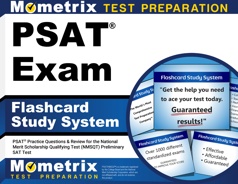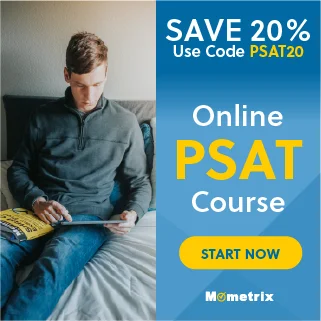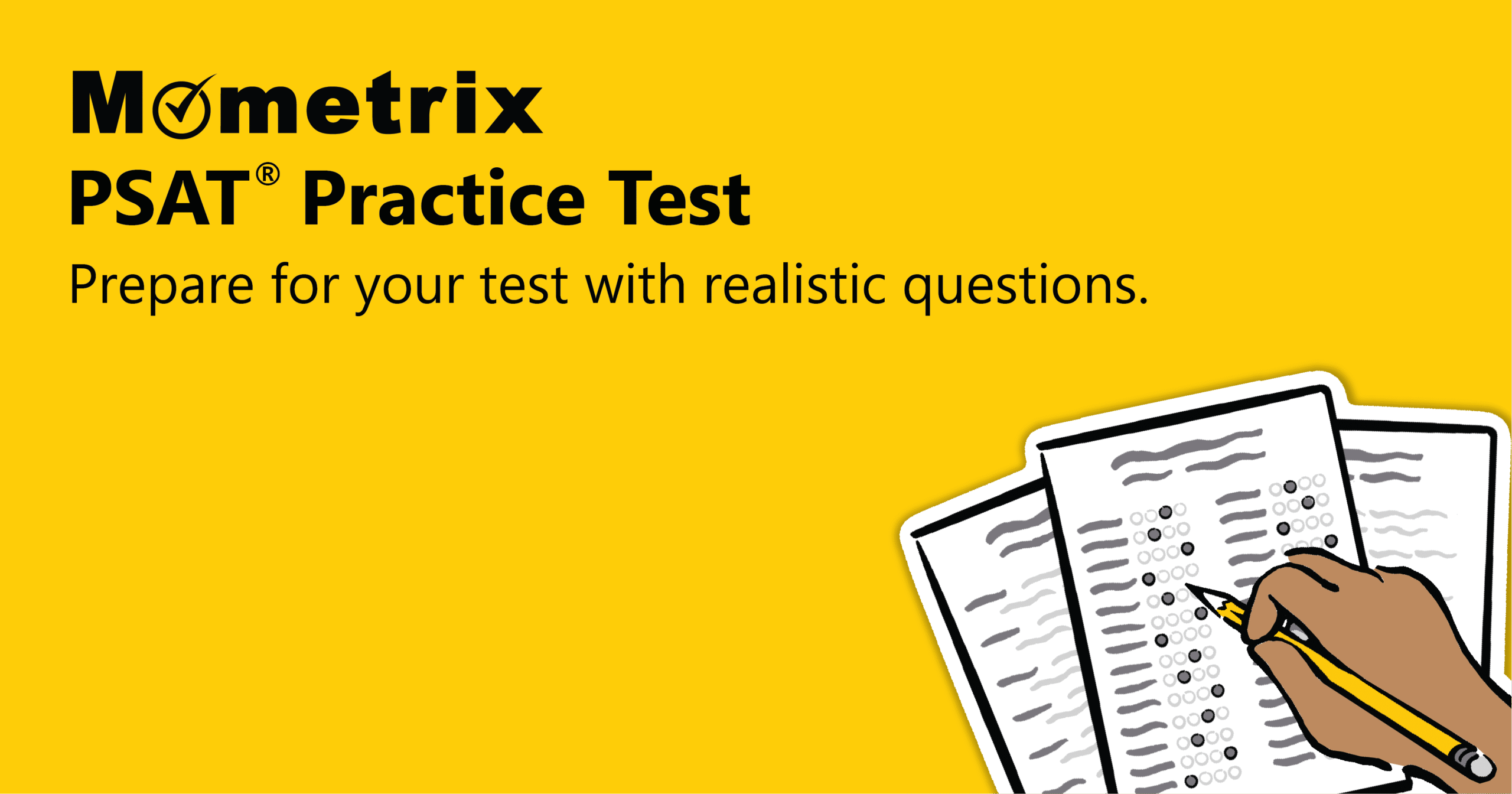Every year, thousands of high school students across the country prepare for the Scholastic Aptitude Test (SAT®). But before they take the SAT, students prepare throughout their high school years by taking the Preliminary SAT/National Merit Scholarship Qualifying Test (PSAT/NMSQT®).
Click the “Start Test” above to begin your free PSAT practice test! These practice questions will give you a better idea of what to study for your exam.
PSAT/NMSQT Practice Tests by Subject
If you need some extra practice in a specific subject, click one of the subjects below to get started on a subject-specific PSAT/NMSQT practice test.
Exam Outline
The PSAT/NMSQT contains a total of 98 questions/tasks and has a time limit of 134 minutes (2 hours and 14 minutes).
Here’s a quick look at what’s on the test:
Check Out Mometrix's PSAT Study Guide
Get practice questions, video tutorials, and detailed study lessons
Get Your Study Guide
How to Pass
Though the PSAT is often considered to be a practice run for the SAT, scoring high enough on the PSAT can qualify you for the National Merit Scholarship Program. Some of these scholarships include full college tuition. Because of the potential reward of scoring well on the PSAT, you want to be adequately prepared for this important exam. Using quality study materials is crucial.
It is also helpful to verify your readiness for the test by taking PSAT practice tests. You don’t have to spend a lot of money on quality PSAT study materials, they are available for free, from Mometrix Academy. The links above give you access to practice test study guides that cover all the subjects included on the PSAT: Reading, Mathematics, and Writing.
There are also links to free practice tests. The PSAT practice tests will assess your knowledge and indicate how prepared you are for the actual PSAT test. A practice test will also pinpoint which subject areas need further study and understanding. You may want to consider taking a PSAT practice test for the first time and designate next to each question which of the subsequent statements is true.
- I confidently knew the correct answer
- I chose the correct answer but was unsure of my choice
- I had no idea which option was the correct answer
Approaching the practice test in this way will help you determine strengths and weaknesses so that you can allocate your study time appropriately. The questions that you confidently answered correctly won’t require much study, but you may want to briefly review this material anyway to verify that you have a thorough understanding of why that was the correct answer. The questions that you answered correctly but were not confident about will need a little more time and focus. Of course, the majority of your study time will be focused on the last set of questions of which you had no idea as to the correct answer. Don’t be disheartened about these questions! Mometrix has all you need to successfully prepare for the PSAT.
Top 5 Most Challenging PSAT Questions
Now that you know how to approach practice tests, try your hand at some targeted practice on your own!
Over the last year, we’ve compiled the data from about 16,000 test-takers who tried their hand at the practice test at the top of this page. According to the data, around 85% of people answered these five questions incorrectly.
Answer each question and read through the answer explanation, whether you got the answer right or wrong. This will help you ensure you’ve got the topic mastered.
Whether you struggled with these questions or aced them on your first try, be sure to take the full practice test to get a better idea of how prepared you really are!
1. The half-life of caffeine in the human body is 5 hours. If Rafe drinks a cup of coffee at 7:00 a.m., what percentage of the caffeine is still in his system at 2:00 p.m.? Round your answer to the nearest whole percent.
We start with the formula where is the starting amount and is the time in hours. Since the half-life is 5, we can write . We then solve by taking the natural logarithm of each side:
At 2:00 p.m., it has been 7 hours since Rafe drank the cup of coffee, so we can put that into the equation:
This translates to 37.9%, or approximately 38%.
2. In triangle ABC below, side and side . What is the length of ?

Subtract from both sides:
Finally, divide each side by :
We can plug this value into the equation for either leg to find that . To find AC, we multiply this by :
Therefore, the length of AC is 8.
3. Which choice completes the text below with the most logical transition?
Florence stood as a shining star in the Italian Renaissance from the 14th century to the 17th century. Thinkers like Leonardo da Vinci, Michelangelo, and Galileo Galilei found a home here, and their groundbreaking contributions became foundations of art and science. __________ the Medici family, well-known supporters of the arts, nurtured an atmosphere where creativity flourished, backing works that would influence art, science, and human thought for years to come.
4. Read the selections below before answering the question:
 Read Passage
Read PassageText 1
Banning books on the basis of what is deemed appropriate by conservative individuals is an injustice to students. The contents of a library should not only reflect the population that the library serves, they should be more diverse. This exposes readers to the lived experiences of others, through which they may develop a sense of empathy and understanding. A diverse collection of books also allows for all patrons to see themselves reflected in the collection. Removing books that may be seen as controversial or inappropriate removes the validation and support that students need to flourish. Students should, instead, be taught the skills needed to think critically and to make appropriate book selections based on their own needs and desires. While parents have the right to decide what is appropriate for their own children, they do not reserve the right to decide for all.
Text 2
As adults, it is our responsibility to protect children from inappropriate topics, graphic content, offensive language, sexual themes, and other unsavory content. Making this content inaccessible to children is the easiest way to protect them and allow them to remain innocent for as long as possible. Books should represent an ideal world of which our children may strive to be an integral part. Perverse topics will only lead children to believe the portrayed lifestyles are acceptable.
Based on the texts, what would the author of the first text most likely say in response to the claims made by the author of the second text?
5. Which of the following is the solution to the following inequality:
Solve the inequality using inverse operations. Start by adding 9 to both sides of the inequality.
Then, divide both sides by 2.
From here, separate the inequality into two inequalities to remove the absolute value, and solve each inequality.
Because the absolute value inequality produces two separate solution regions, the solution is or .
Check Out Mometrix's PSAT Flashcards
Get complex subjects broken down into easily understandable concepts
Get Your Flashcards

PSAT Online Prep Course
If you want to be fully prepared, Mometrix offers an online PSAT prep course designed to give you everything you need to succeed!
Here’s what you’ll find in the PSAT course:
Everyone learns differently, so we’ve tailored the PSAT online prep course to ensure every learner has what they need to prepare for the PSAT exam.
Click below to check it out!
PSAT/NMSQT® is a trademark registered by the College Board and the National Merit Scholarship Corporation, which are not affiliated with, and do not endorse, this page.
As an Amazon Associate I earn from qualifying purchases.





